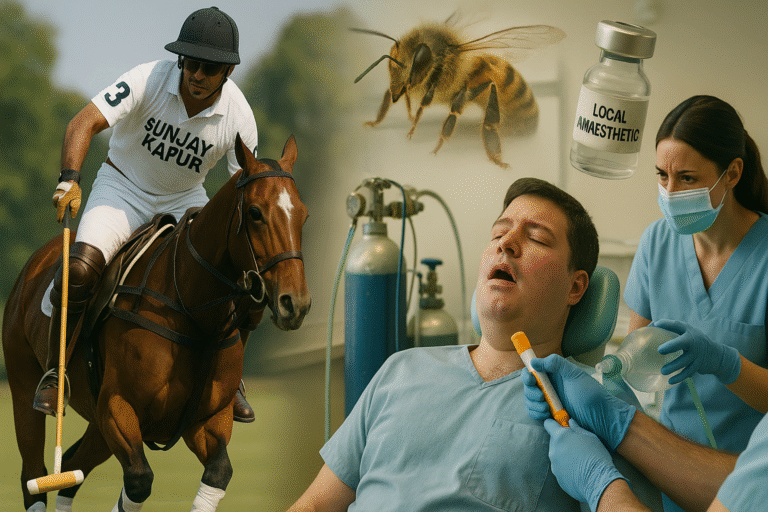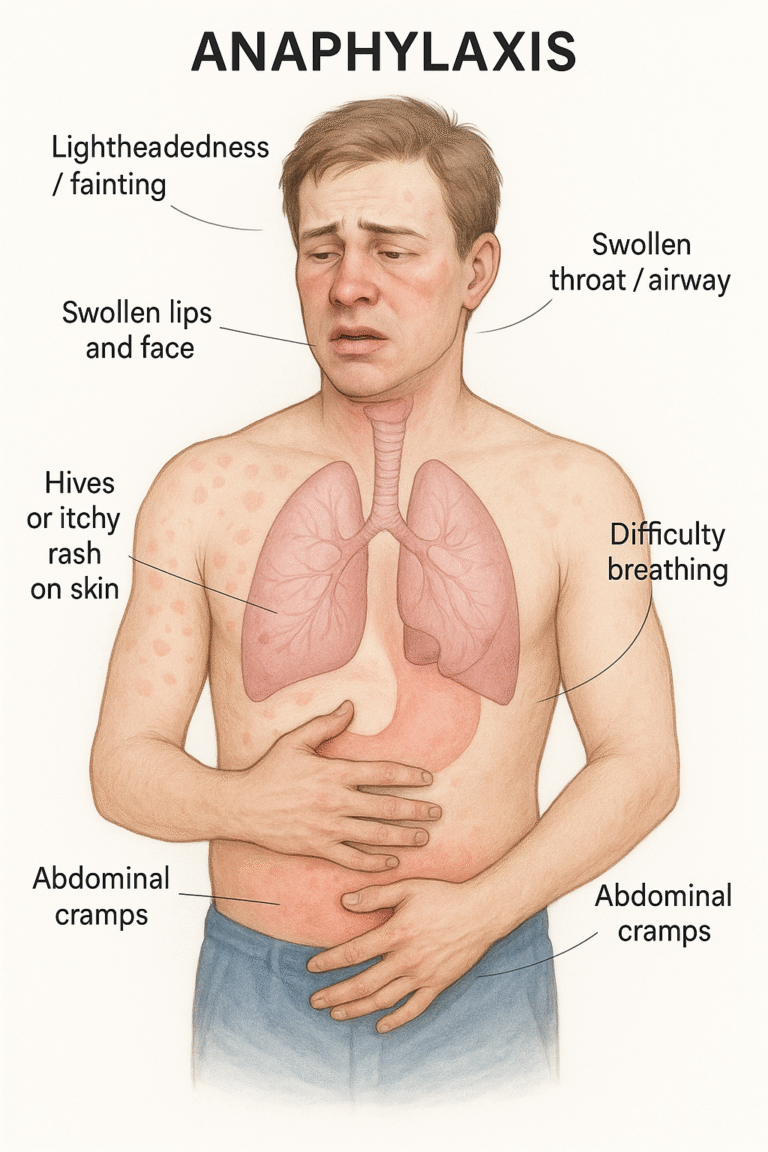When Seconds Matter: Anaphylaxis and the Sudden Death of Sunjay Kapur
Health Desk – Martian Smiles Lab
New Delhi, UPDATED June 15, 2025 17:04 PM

The sudden death of billionaire businessman Sunjay Kapur from a bee sting during a polo match in England has shocked many. Moments before collapsing, he reportedly said, “I think I swallowed something.” It’s believed he accidentally swallowed a bee that stung him inside his throat, triggering a deadly allergic reaction known as anaphylaxis. Despite doctors rushing to help, the reaction progressed too rapidly and tragically claimed his life.
Kapur, a close friend of Prince William and ex-husband of Bollywood actress Karisma Kapoor, was a familiar face in elite circles, but his passing has raised awareness about a health risk that doesn’t discriminate by wealth or status.
Allergic reactions like his aren’t limited to outdoor sports or exotic locations. They can happen in places we normally consider safe — like dental or Medical clinics. In fact, many people unknowingly get exposed to potential allergens during routine dental treatments. That’s why this issue matters — not just to doctors and dentists, but to everyday people like you and us who might visit the dentist for something as simple as a filling or a cleaning
What Is Anaphylaxis? Understanding the Silent Killer

Anaphylaxis is a sudden and severe allergic reaction that can be deadly if not treated quickly. It happens when your body overreacts to something it mistakenly sees as harmful — like a bee sting, a food item, or a medication. Your immune system releases chemicals that cause symptoms such as:
- Swelling of the lips, face, or throat
- Hives or itchy skin
- Trouble breathing
- Stomach cramps or vomiting
- Feeling faint or passing out
The most dangerous part? Medical experts believe the Sunjay Kapur bee sting reaction led to airway closure within minutes and his blood pressure dropped so fast that his heart stopped. That’s why anaphylaxis is a true medical emergency.
How the Sunjay Kapur Bee Sting Turned Deadly in Minutes
Sports go beyond the game— it builds character, teaches resilience, and brings out the best in us. The lessons learnt on the field shape who we are off it, instilling values that last a lifetime. It’s also the best way to keep healthy both mentally & physically. Celebrating the… pic.twitter.com/rYdo5v6xyE
— Sunjay Kapur (@sunjaykapur) August 29, 2024
Time is everything when it comes to anaphylaxis. In the most severe cases, death can occur in less than 15 minutes. When an allergen like bee venom enters the system, it can trigger a cascade of immune responses, including airway swelling, a sudden drop in blood pressure, and circulatory collapse. If the throat swells shut—as is suspected to have happened to Sunjay Kapur—it becomes a race against the clock to restore breathing.
What’s especially important in Kapur’s case is that the allergic reaction didn’t occur while he was resting — he was in the middle of playing polo, a sport that is physically demanding and intense. Exercise can act as a co-factor in anaphylaxis, meaning it can accelerate or amplify the body’s reaction to an allergen. When you combine the adrenaline and physical exertion of high-speed horseback riding with a sudden internal bee sting, the risk increases dramatically.
Bee Sting Anaphylaxis: More Common Than You Think
Arguably the most important intervention I performed on shift today was capturing a bee that snuck in on a patient who presented with anaphylaxis from a different bee sting. pic.twitter.com/5DyvdcsRsJ
— Andrew Eyre (@AndrewEyreMD) September 12, 2020
While it sounds rare, anaphylaxis from insect stings is surprisingly common. Bee, wasp, and hornet venom are among the most potent natural allergens. According to health authorities, thousands of people globally suffer severe reactions each year. Just months ago, in Ireland, a 56-year-old man named Michael Sheehan died after being stung by a swarm of wasps while gardening. These incidents, though often underreported, highlight that no setting—whether it’s a backyard or a royal polo field—is immune.
Anaphylaxis in Unlikely Places: The Dental Clinic
Australian girl’s reaction to milk protein in a tooth treatment re-raises the concerns about food exposure risks at the dentist’s office: https://t.co/x18oq1REbL #foodallergy #milkallergy @AAAAI_org pic.twitter.com/HrtZ5dZ6gt
— Allergic Living (@AllergicLiving) June 24, 2019
Most people don’t think of the dentist’s chair as a place for life-threatening emergencies. But it can be. Here’s why:
- Local Anesthetics: The numbing injections used in dental procedures can sometimes cause allergic or toxic reactions.
- Latex Gloves: Some patients are allergic to latex without knowing it.
- Mouthwashes and Cleaning Agents: Ingredients like chlorhexidine can trigger reactions in sensitive individuals.
- Stress and Fear: Feeling anxious at the dentist can also lead to fainting or unusual responses that look like allergic reactions.
Even if you’ve had dental work before without problems, your body can still react unexpectedly. That’s why every clinic should be prepared. While the Sunjay Kapur bee sting happened on a polo field, similar anaphylactic reactions can occur in dental clinics too.
Warning Signs Dentists and Medical Staff Must Not Ignore
I developed anaphylaxis to an allergy shot yesterday morning. An NP and a few nurses saved my life.
— Robert Oubre, MD | The Doctor of Documentation (@Dr_Oubre) October 22, 2022
They did a great job of identifying early symptoms and did not delay in giving me Epi. Took care of my kid during the episode too.
Remember, anaphylaxis ➡️ Epi 1st. Not steroids.
Anaphylaxis often begins subtly. A mild rash, itchy palms or scalp, tingling lips, or a strange throat sensation may be the body’s first warning. Some patients feel a sudden wave of unease or a sense of impending doom — a surprisingly common early symptom. These can appear within minutes of exposure to triggers like local anesthetics, latex gloves, chlorhexidine, or certain antibiotics.
What happens next can unfold with terrifying speed:
Swelling of the lips and throat, making it difficult to breathe or swallow.
Wheezing or tightness in the chest, often mistaken for a panic attack.
Rapid heartbeat, drop in blood pressure, dizziness, and ultimately, loss of consciousness.
That’s why it’s crucial for dentists and their teams to stay alert, especially within the first few minutes of administering any medication or using chemical products.
Emergency Preparedness: Are Clinics Ready to Save Lives?
Anaphylaxis is always anemergency -- which is what makes epinephrine injectors so important. https://t.co/B9AGjumzRT pic.twitter.com/x4LeI3JlOG
— WebMD (@WebMD) August 30, 2016
The good news? Anaphylaxis is treatable. The bad news? Many clinics, dental or otherwise, may not be fully prepared. Every dental practice should not only stock epinephrine auto-injectors but also conduct regular anaphylaxis training drills, know the correct dosage protocols, and have a clear emergency response plan in place. Anaphylaxis is rare — but when it happens, recognition and speed are the difference between life and death.
If you’re a patient, don’t be afraid to ask your dentist if they have emergency measures in place.
How Can You Protect Yourself as a Patient?
You can take simple steps to reduce your risk:
- Share your full medical history with your dentist or medical professional — including past allergies or reactions.
- Let them know if you have asthma, food allergies, or have ever reacted to a drug.
- Ask questions about what medications or materials they’ll use.
- Pay attention to how you feel during and after treatment — even small changes like itching or dizziness matter.
Remember, early symptoms of anaphylaxis can look like nothing serious — just a rash or a tickle in the throat. But they can escalate fast.
Why Awareness Can Save Lives
Billionaire Sunjay Kapur’s sudden death is a powerful reminder of how fast allergies can become fatal. You don’t need to be in a jungle or on a polo field — even a dentist’s office or clinic can be the setting.
That’s why we all need to be more aware. Whether you’re a patient or a professional, knowing the signs of anaphylaxis and having a plan in place can be the difference between life and death.
Curious about how popular medications can affect your mouth? Don’t miss our deep dive into the oral side effects of Ozempic — it might surprise you
Official Address
- Bonn, Germany
- Victoria, Mahe Island, Seychelles
- New Delhi, India.
- info@drbibhakarranjan.com
- +49 15560 936114
Copyright 2025 Dr Bibhakar Ranjan – All Rights Reserved
